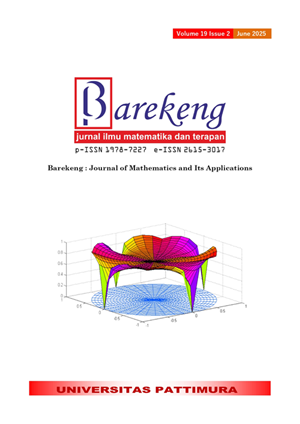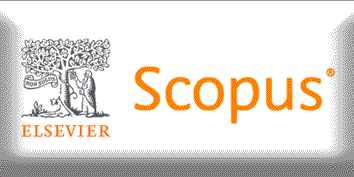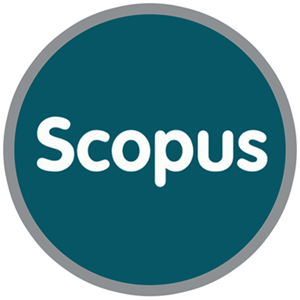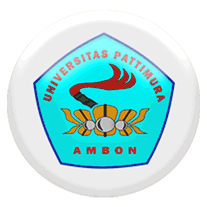A COMPARATIVE STUDY ON NUMERICAL SOLUTIONS OF INITIAL VALUE PROBLEMS OF DIFFERENTIAL EQUATIONS USING THE THREE NUMERICAL METHODS
Abstract
Numerical methods are crucial for solving ordinary differential equations (ODEs) that frequently arise in various fields of science and engineering. This study compares three numerical methods: the fourth-order Runge-Kutta method (RK4), the fourth-order Runge-Kutta Contra-harmonic Mean method (CoM4), and the fourth-order Adam-Bashforth-Moulton method (ABM4) in solving initial value problems of ODEs. Three IVPs of ODEs have been solved with varying step sizes using the three methods that have been proposed, and the solutions for each step size are examined. Numerical comparisons between RK4, CoM4, and ABM4 methods have been presented to solve three initial problems of ODE. Simulation results show that each method has advantages and limitations depending on the type of ODE being solved. We find that for very small step sizes, the numerical solutions agree the best with the exact solution. As such, all three proposed approaches are sufficient to solve the IVP ODE accurately and efficiently. Among the three proposed methods, we observe that the mean absolute error for the RK4 method is the smallest, followed by the ABM4 method.
Downloads
References
M. A. Arefin, B. Gain, and R. Karim, “ACCURACY ANALYSIS ON SOLUTION OF INITIAL VALUE PROBLEMS OF ORDINARY DIFFERENTIAL EQUATIONS FOR SOME NUMERICAL METHODS WITH DIFFERENT STEP SIZES,” International Annals of Science, vol. 10, no. 1, pp. 118–133, February 2021.
M. A. Islam, “A COMPARATIVE STUDY ON NUMERICAL SOLUTIONS OF INITIAL VALUE PROBLEMS (IVP) FOR ORDINARY DIFFERENTIAL EQUATIONS (ODE) WITH EULER AND RUNGE KUTTA METHODS,” American Journal of computational mathematics, vol. 5, no. 03, pp. 393–404, September 2015.
M. A. Islam, “ACCURACY ANALYSIS OF NUMERICAL SOLUTIONS OF INITIAL VALUE PROBLEMS (IVP) FOR ORDINARY DIFFERENTIAL EQUATIONS (ODE),” IOSR Journal of Mathematics, vol. 11, no. 3, pp. 18–23, June 2015.
M. A. Islam, “ACCURATE SOLUTIONS OF INITIAL VALUE PROBLEMS FOR ORDINARY DIFFERENTIAL EQUATIONS WITH THE FOURTH ORDER RUNGE KUTTA METHOD,” Journal of Mathematics Research, vol. 7, no. 3, p. 41, January 2015.
M. Kamruzzaman and M. C. Nath, “A COMPARATIVE STUDY ON NUMERICAL SOLUTION OF INITIAL VALUE PROBLEM BY USING EULER’S METHOD, MODIFIED EULER’S METHOD AND RUNGE–KUTTA METHOD,” Journal of computer and mathematical sciences, vol. 9, no. 5, pp. 493–500, May 2018.
M. B. Hossain, M. J. Hossain, M. M. Miah, and M. S. Alam, “A COMPARATIVE STUDY ON FOURTH ORDER AND BUTCHER’S FIFTH ORDER RUNGE-KUTTA METHODS WITH THIRD ORDER INITIAL VALUE PROBLEM (IVP),” Applied and Computational Mathematics, vol. 6, no. 6, pp. 243–253, November 2017.
A Papalia, Y.A. Lesnussa, M. E. Rijoly, and O. J. Peter, “NUMERICAL SOLUTION OF THE SEIR MODEL USING THE FOURTH-ORDER RUNGE-KUTTA METHOD TO PREDICT THE SPREAD OF HEPATITIS B DISEASE IN AMBON CITY,” BAREKENG: Jurnal Ilmu Matematika dan Terapan, vol. 18, no. 3, pp. 2047–2056, Sep. 2023.
Z. M. Maibed and M. S. Mechee, “A COMPRESSION STUDY OF MULTISTEP ITERATIVE METHODS FOR SOLVING ORDINARY DIFFERENTIAL EQUATIONS,” International Journal of Liability and Scientific Enquiry, vol. 2, pp. 1–8, February 2020.
H. Rahaman, M. K. Hasan, A. Ali, and M. S. Alam, “IMPLICIT METHODS FOR NUMERICAL SOLUTION OF SINGULAR INITIAL VALUE PROBLEMS,” Applied Mathematics and Nonlinear Sciences, vol. 6, no. 1, pp. 1–8, April 2021.
Md. M. I. Sumon and Md. Nurulhoque, “A COMPARATIVE STUDY OF NUMERICAL METHODS FOR SOLVING INITIAL VALUE PROBLEMS (IVP) OF ORDINARY DIFFERENTIAL EQUATIONS (ODE),” American Journal of Applied Mathematics, vol. 11, no. 6, pp. 106-118, November 2023.
O. C. Nnamdi, O. S. Adelaja, and O. B. Johnson,”ON THE COMPARISON OF ADAM-BASHFORTH AND ADAM MOULTON METHODS FOR NON-STIFF DIFFERENTIAL EQUATIONS,” Asian Research Journal of Mathematics, vol. 18, no. 11, pp. 116-129, September 2022.
I. N. Fikri and Sumardi, “THE SIMULATION OF ONE-DIMENSIONAL SHALLOW WATER WAVE EQUATION WITH MACCORMACK SCHEMES”, BAREKENG: Jurnal Ilmu Matematika dan Terapan, vol. 16, no. 2, pp. 729-742, June 2022.
C. H. Edwards, D. E. Penney, and D. T. Calvis, DIFFERENTIAL EQUATIONS AND BOUNDARY VALUE PROBLEMS: COMPUTING AND MODELING. USA: Pearson Higher Ed, 2016.
W. E. Boyce, R. C. DiPrima, and D. B. Meade, ELEMENTARY DIFFERENTIAL EQUATIONS AND BOUNDARY VALUE PROBLEMS. New York: John Wiley & Sons, 2021.
B. R. Hunt, R. L. Lipsman, J. E. Osborn, and J. M. Rosenberg, DIFFERENTIAL EQUATIONS WITH MATLAB. New York: John Wiley & Sons, 2019.
R. L. Burden and J. D. Faires, NUMERICAL ANALYSIS,” Numerical analysis, Brooks/Cole, 2011.
J. C. Butcher, Numerical Methods For Ordinary Differential Equations. New York: John Wiley & Sons, 2016.
S. T. Karris, NUMERICAL ANALYSIS USING MATLAB AND EXCEL. California: Orchard Publications, 2007.
A. Ü. Keskin, ORDINARY DIFFERENTIAL EQUATIONS FOR ENGINEERS: PROBLEMS WITH MATLAB SOLUTIONS. New York: Springer, 2018.
A. H. Workie, “NEW MODIFICATION ON HEUN’S METHOD BASED ON CONTRA-HARMONIC MEAN FOR SOLVING INITIAL VALUE PROBLEMS WITH HIGH EFFICIENCY,” Journal of Mathematics, vol. 2020, no. 1, p. 6650855, December 2020.
D. J. Evans and A. R. Yaakub, “A NEW FOURTH ORDER RUNGE-KUTTA FORMULA BASED ON THE CONTRA-HARMONIC (CoM) MEAN,” International Journal of Computer Mathematics, vol. 57, no. 3-4, pp. 249–256. 1995.
E. Setiawan and M. Imran, “A WEIGHTED FOURTH ORDER RUNGE-KUTTA METHOD BASED ON CONTRA-HARMONIC MEAN,” J. Math. Comput. Sci., vol. 6, no. 6, pp. 989–1001, May 2016.
Z. J. Kadum and N. Y. Abdul-Hassan, “NEW NUMERICAL METHODS FOR SOLVING THE INITIAL VALUE PROBLEM BASED ON A SYMMETRICAL QUADRATURE INTEGRATION FORMULA USING HYBRID FUNCTIONS,” Symmetry, vol. 15, 631. March 2023.
Copyright (c) 2025 Marsudi Marsudi, Isnani Darti

This work is licensed under a Creative Commons Attribution-ShareAlike 4.0 International License.
Authors who publish with this Journal agree to the following terms:
- Author retain copyright and grant the journal right of first publication with the work simultaneously licensed under a creative commons attribution license that allow others to share the work within an acknowledgement of the work’s authorship and initial publication of this journal.
- Authors are able to enter into separate, additional contractual arrangement for the non-exclusive distribution of the journal’s published version of the work (e.g. acknowledgement of its initial publication in this journal).
- Authors are permitted and encouraged to post their work online (e.g. in institutional repositories or on their websites) prior to and during the submission process, as it can lead to productive exchanges, as well as earlier and greater citation of published works.






1.gif)



